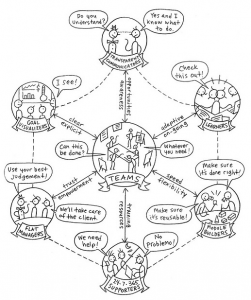
Communicating Culture with Positive Reinforcement
A lot of big words for a simple theory. Or as Boyd so eloquently puts it in the recent Fast Company article, “People want to be inspired, not lectured. They tend to respond better to humor and gentle reminders than they do to dictates or presumptions of guilt before innocence.” In essence, people don’t respond as well to control as they do to subtle encouragement.
Many people think of organizational culture as a ‘soft’ skill, yet culture is directly related to the execution of your organization’s strategy. What is the ultimate goal within your company? What type of work do you want your employees to create? What type of attitude and atmosphere are you trying to construct? If you know where you want to take your company, then define the behaviors, values and attitudes that you want your employees to emulate as they execute your company’s strategy.

XPLANE’s Culture Map, Courtesy of Dave Gray
For example, one organization I work with values ‘customer service’. Yet customer service can be defined 100 different ways to 100 different people. It’s up to the leadership team to define what customer service actually means in practice in your organization. What’s the behavior and attitude that reflects excellent customer service? Is it a smile upon meeting? Always saying hello first? Do the employees have the authority to do whatever it takes to keep the customer happy, up to a certain dollar amount? These are the type of questions that need to be answered so the team can create the culture that is needed to execute your strategy.
Once your organizational values, behaviors and attitudes are defined, how do you enforce those cultural standards? While the strategy might be compelling, the article mentions using positive reinforcement to increase or maintain a certain type of behavior. Positive reinforcement refers to the behavioral and reinforcement theories developed by B.F. Skinner, in which positive reinforcement is the addition of an appetitive stimulus.
Again, a lot of big words for a simple, effective idea. What does this mean? Provide affirmative incentives. Incentives don’t necessarily need to be tangible, as we’ll discuss in the next post. Intangible are often best. In the case of Burning Man, reinforcement is provided with the use of humor. Humor in unexpected places is a nice surprise and reprieve from what could come across as a dry dictate; it helps employees to want to pay attention.
That’s what it boils down to. To foster a positive, productive, enjoyable culture, with happy employees producing superb results – take care to provide positive feedback where culture has been embraced or in areas you are trying to build up and develop. The result? Employees are inspired to take part and contribute to the organizational culture as they execute their daily tasks.
Let’s share experiences. Leave a comment below, send me an email, or find me on Twitter.


Leave A Comment